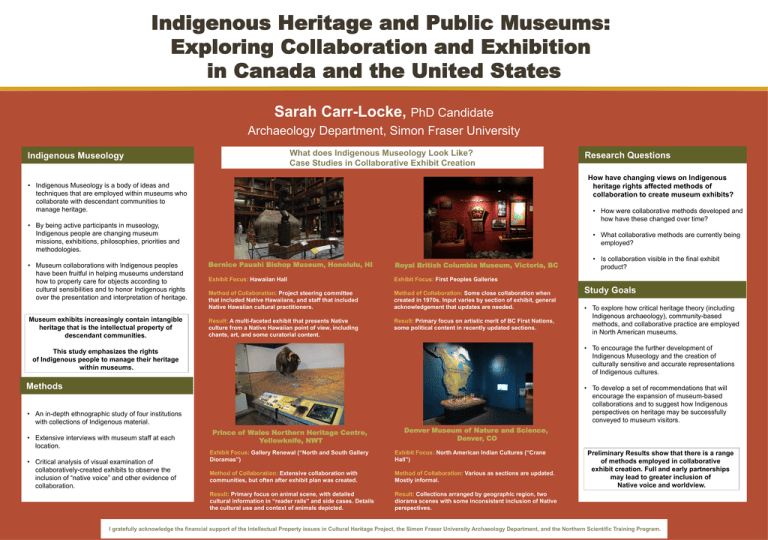Indigenous Heritage and Public Museums: Exploring Collaboration and Exhibition
advertisement

Indigenous Heritage and Public Museums: Exploring Collaboration and Exhibition in Canada and the United States Sarah Carr-Locke, PhD Candidate Archaeology Department, Simon Fraser University What does Indigenous Museology Look Like? Case Studies in Collaborative Exhibit Creation Exhibit Focus: North American Indian Cultures (“Crane Hall”) Method of Collaboration: Various as sections are updated. Indigenous Museology How have changing views on Indigenous heritage rights affected methods of collaboration to create museum exhibits? • Indigenous Museology is a body of ideas and techniques that are employed within museums who collaborate with descendant communities to manage heritage. • How were collaborative methods developed and how have these changed over time? • By being active participants in museology, Indigenous people are changing museum missions, exhibitions, philosophies, priorities and methodologies. • Museum collaborations with Indigenous peoples have been fruitful in helping museums understand how to properly care for objects according to cultural sensibilities and to honor Indigenous rights over the presentation and interpretation of heritage. Museum exhibits increasingly contain intangible heritage that is the intellectual property of descendant communities. • What collaborative methods are currently being employed? Bernice Pauahi Bishop Museum, Honolulu, HI Royal British Columbia Museum, Victoria, BC Exhibit Focus: Hawaiian Hall Exhibit Focus: First Peoples Galleries Method of Collaboration: Project steering committee that included Native Hawaiians, and staff that included Native Hawaiian cultural practitioners. Method of Collaboration: Some close collaboration when created in 1970s. Input varies by section of exhibit, general acknowledgement that updates are needed. Result: A multi-faceted exhibit that presents Native culture from a Native Hawaiian point of view, including chants, art, and some curatorial content. Result: Primary focus on artistic merit of BC First Nations, some political content in recently updated sections. Methods Study Goals • To explore how critical heritage theory (including Indigenous archaeology), community-based methods, and collaborative practice are employed in North American museums. • To develop a set of recommendations that will encourage the expansion of museum-based collaborations and to suggest how Indigenous perspectives on heritage may be successfully conveyed to museum visitors. • An in-depth ethnographic study of four institutions with collections of Indigenous material. • Critical analysis of visual examination of collaboratively-created exhibits to observe the inclusion of “native voice” and other evidence of collaboration. • Is collaboration visible in the final exhibit product? • To encourage the further development of Indigenous Museology and the creation of culturally sensitive and accurate representations of Indigenous cultures. This study emphasizes the rights of Indigenous people to manage their heritage within museums. • Extensive interviews with museum staff at each location. Research Questions Prince of Wales Northern Heritage Centre, Yellowknife, NWT Denver Museum of Nature and Science, Denver, CO Exhibit Focus: Gallery Renewal (“North and South Gallery Dioramas”) Exhibit Focus: North American Indian Cultures (“Crane Hall”) Method of Collaboration: Extensive collaboration with communities, but often after exhibit plan was created. Method of Collaboration: Various as sections are updated. Mostly informal. Result: Primary focus on animal scene, with detailed cultural information in “reader rails” and side cases. Details the cultural use and context of animals depicted. Result: Collections arranged by geographic region, two diorama scenes with some inconsistent inclusion of Native perspectives. Preliminary Results show that there is a range of methods employed in collaborative exhibit creation. Full and early partnerships may lead to greater inclusion of Native voice and worldview. I gratefully acknowledge the financial support of the Intellectual Property issues in Cultural Heritage Project, the Simon Fraser University Archaeology Department, and the Northern Scientific Training Program.







